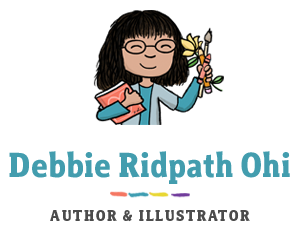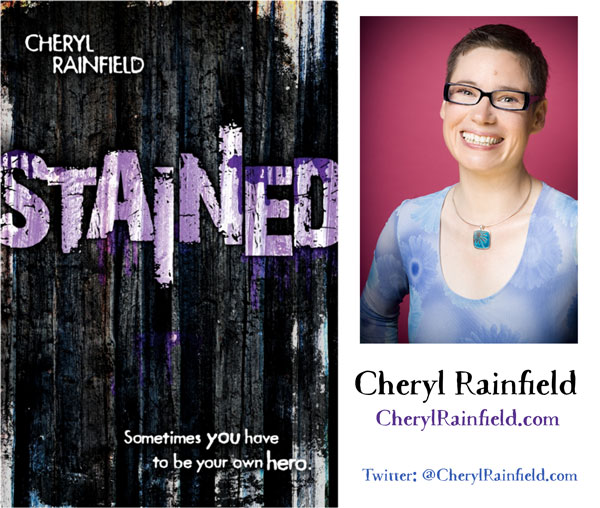
I met Cheryl Rainfield through the Toronto Area Middle Grade/YA Author Group (also known as Torkidlit) and am a big fan of her work (especially SCARS and HUNTED in the past). A survivor of abuse, Cheryl often draws upon her own experience in her intense and highly charged fiction. I love Cheryl’s enthusiasm for kidlit/YA as well as her positive outlook and support of others in the community.
STAINED was named one of Bank Street College’s Best Books Of The Year (2014) for ages 14 and up, and was a SCBWI Crystal Kite Finalist.
For those in the Toronto area: Cheryl will be speaking about STAINED and signing copies (as well as of SCARS and HUNTED) at Chapters Scarborough at 2 pm on Saturday, Sept. 13th, 2014.
Where you can find Cheryl Rainfield: Website – Blog – Twitter – Facebook Personal/Pro – Tumblr – Instagram – Pinterest
Q. What’s your writing process? Or What was your writing process for STAINED?
A. I write and edit my manuscripts by hand. Longhand writing feels more connected to my inner voice, my creativity, and more alive. And then I type the writing into MS Word. At various points, I also send out my manuscript to other writers to get feedback, and then I revise again. For STAINED, I did about thirteen drafts before it sold to Houghton Mifflin Harcourt, and then multiple drafts before it was published. At one point my editor Karen Grove asked me to try writing some scenes from the abductor’s point of view. I tried, but I think because what I wrote about was so personal—I was drawing on my own trauma and abuse experience—and because I can’t bear to be in the head of an abuser, especially an abuser character based on my own abuser—I found it painful and I struggled writing those scenes. Ultimately I took those scenes out; the book worked better, the way I could write it, with just Sarah and Nick’s alternating viewpoints.
STAINED was the first book I’ve written where I used two different perspectives, and I really enjoyed the process. I put a lot of myself into both Sarah and Nick. I think the alternate points of view helped fill in the gaps in Sarah’s story that she couldn’t know about from her perspective, gave the reader a small breather, and sometimes worked to increase the tension. I also used them to gradually develop the relationship between Sarah and Nick, and the awareness that they really loved each other.
I typically write a lot of drafts quickly, always trying to make the writing and story better, stronger, more powerful, and often doing drafts focused on different things each time. In early drafts, I tend to write the conflicts and tension, the emotion in the characters, the action and plot, and tend to leave out description and setting—I think because as a person and an abuse survivor that’s what I notice most in the world: tension, body language, emotion. So then I have to go back in and layer those things in, as well as symbols and metaphors if I’ve left them out.
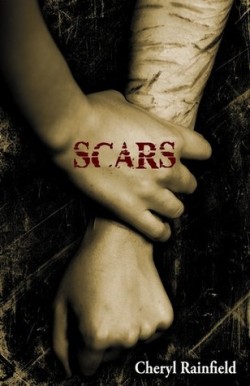
I also usually have to go back in and intentionally add lightness and breathing room for the reader. I’m so used to tension and fear and and pain—it’s what I lived most of my life and know inside out—that putting in happier moments has to be very intentional on my part. I also think tension and conflict helps make a book a page turner—but readers need breathing room, too. I had a lot of fun giving Sarah and Nick a love of comics and superheroes in STAINED, since I also love and read them, and I also enjoyed making Nick draw (I do, too), giving him geeky technological savviness (also my love), and giving Sarah the strength and courage to stand up to bullies who were harassing other kids (also part of myself). And I managed, probably for my first book ever, to give my main character two really good parents–something that comes from my finally having some loving, safe people in my life, and especially my therapist. I think I’m getting better at adding in lightness in my early drafts.
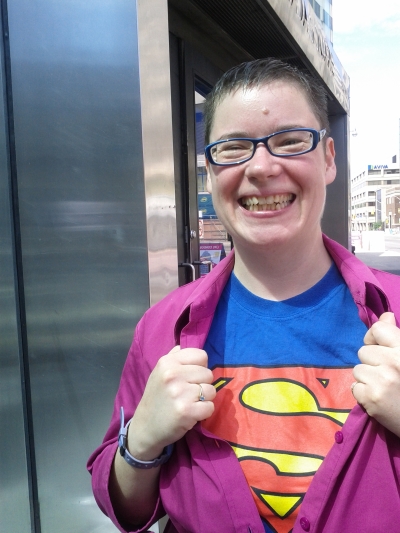
I used to be a pantser writer, not wanting to feel confined by outlines, but I now do outlines with the knowledge that I can change them—and they help me write a lot better, faster. With every book I write, I use THE ANATOMY OF STORY by John Truby to help guide my initial focus, character and plot building, and outline, and also at least my first draft. I’ve found that book incredibly helpful and valuable, as well as a lecture I attended by Donald Maass where I learned a lot more about symbols, parallels, and reversals, which I also add in. And I always, always get feedback from other writers and polish my work before sending it on to my agent. I want my writing to be as polished as it can be before I submit it, so that it’s more likely to get published.
Q. How did STAINED get published?
A. My agent at the time—Andrea Somberg at Harvey Klinger—submitted my manuscript to editors and found a home for STAINED at Houghton Mifflin Harcourt. This was a relief to me, since WestSide, the publisher who’d published SCARS and HUNTED, had closed just before HUNTED came out, and I needed a new, stable, and good publishing home. Houghton Mifflin Harcourt has been fantastic with me and STAINED, releasing STAINED in the US, Canada, and the UK, in print, ebook, and audiobook formats. It’ll also be coming out in a cheaper paperback format mid-2015; I’m excited about that!
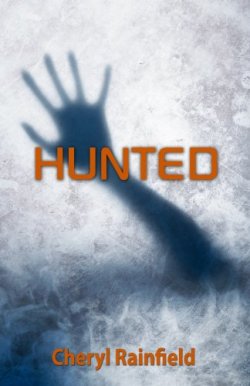
I think having a good agent vastly improves a writer’s chances of getting a manuscript published; an agent can submit work to publishers who are closed to writers without agents, and that includes most of the big publishing houses. Although you can get published without an agent, it’s a lot harder. I also learned when I attended college for an editing certificate that publishers generally have two standard contracts—one for authors without an agent, and one for authors with an agent. And the contract for authors with an agent automatically starts at higher royalty rates and better clauses and options. And a good agent knows editors personally and can figure out what manuscript to place with what editor, and also help guide a writer’s career. So I knew I needed an agent.
I actually got my first contract by myself—through the slushpile with WestSide Books—but after years of research, reading writing technique books, publishing industry books, and articles, I knew I needed an agent to negotiate the contract for me, and to help advance my career. I’d initially queried Andrea with HUNTED, which she’d rejected, but her rejection letter was one of the nicest and longest I’d received, and she mentioned hoping to work with me on another book. Her letter stood out to me. So when I got an offer for SCARS (two offers, actually, almost at the same time), I contacted her and asked if she’d represent me, and she did. She also sold HUNTED, and of course STAINED, and I’m grateful for all her help.
Traditional publishing can be slow. I signed the final contract for STAINED in February 2012; I think we got the offer in late 2011, worked on the edits in 2012 (and waited for feedback in between), and then STAINED was published in October 2013. But there’s so much that goes into producing a book—not just the content editing, but also copyediting, proofreading, cover design, interior design and layout, jacket copy, and then also promotion and distribution.
I love what Houghton Mifflin Harcourt did with STAINED—the designer did an incredible, tasteful job with the final cover, pulling a rich, deep purple into the title (because Sarah has a purpleish port-wine stain on her cheek that she obsesses about) and also into the endpapers, and black vertical streaks reminiscent of the cabin Sarah was locked in; the gorgeous texture to the matte jacket; featuring the tagline on the cover: “Sometimes you have to be your own hero;” picking a worn, broken-looking font for the chapter heads with the name and time stamps and initial first words in the first paragraph; using nicely textured cream paper; the readable typeset; and the tiny visual surprise on the hardcover along the spine beneath the book jacket—the title, my name, and publisher info in a gorgeous iridescent purple. I love how a book looks, as you may be able to tell (laughing) so it was a delight to have such care taken with STAINED. Holding a finished book that you wrote for the first time is such a joy.

Q. What advice do you have for aspiring YA writers?
A. First—if your dream is to get published, don’t give up.
You may face a lot of rejection over time, but if you persist I think you’ll eventually get published. It took me more than ten years and hundreds of rejections from both editors and agents before I got SCARS published. If I’d given up before then—and in the last few years I was very despairing—then I might never have been published.
Edit your work over and over until it sounds right. One trick I use for some drafts is to read my manuscript aloud. I can hear what works and what doesn’t better that way. It also helps to put your manuscript away for at least a week (I often do two to even four weeks) between drafts before editing again, so that you have as clear a read as possible and can see what’s really working and what really isn’t.
Make sure to get honest feedback from other writers; that can help you advance so much as a writer. Don’t change everything based on what others say, though; make sure to listen to your gut, and to change what feels right. Let the manuscript and feedback sit for a week or more before acting on it unless you’re absolutely sure. I found that joining a critique group of other writers who wrote in the same genre I did helped me immensely; I not only got great feedback, but I also got to hear what worked and what didn’t in others’ writing, and learn from that.
Learn the craft of writing—attend conferences and professional talks, read articles online such as K.M. Weiland’s Helping Writers Become Authors and in magazines such as Writer’s Digest, and most especially read books on writing technique (if you can learn that way) or take some classes.
Writing technique books have really helped me; I’ve read (and bought) more than a hundred books on technique, and I go back and reread some of them and glean new things as I progress as a writer.
If you can’t afford to buy them, don’t forget about your library! I list a lot of writing technique books I recommend on my blog and website. Two of the most helpful books I read when starting out are Self-Editing For Fiction Writers: How To Edit Yourself Into Print by Renni Brown and Dave King, and Live Writing: Breathing Life Into Your Words by Ralph Fletcher. Later, when I’d learned a lot more about writing technique, some books that really helped me a lot are Techniques of the Selling Writer by Dwight V. Swain, and Bestseller: Secrets of Successful Writing by Celia Brayfield. And right now, my top three current favorites are The Anatomy of Story: 22 Steps To Becoming a Master Storyteller by John Truby, Stein On Writing: A Master Editor of Some of the Most Successful Writers of Our Time Shares His Craft Techniques and Secrets by Sol Stein, and Wired For Story: The Writer’s Guide To Using Brain Science To Hook Readers From The Very First Sentence by Lisa Cron. I also highly recommend The Emotion Thesaurus: A Writer’s Guide To Character Expression by Angela Ackerman and Becca Puglisi.
Learn from them, take what works for you, and discard the rest.
Read. Read as much as you can—for pleasure and for craft. Read in the genre you write in (and hopefully love to read); you’ll learn from it, and you’ll also fill your own creative well. And write about what you care deeply about. Your readers will sense your passion and respond to it.
———–
For more insights from book creators, see my Inkygirl Interview Archives and Advice For Young Writers And Illustrators From Book Creators.

